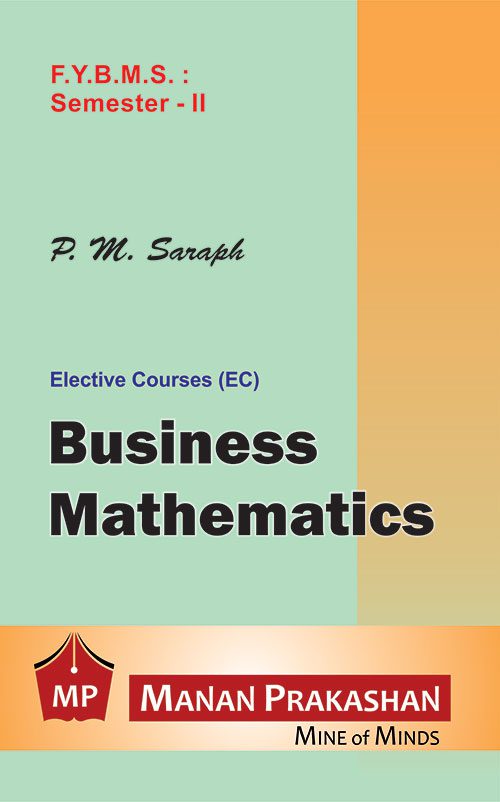Business Mathematics FYBMS Semester II Manan Prakashan
Content:
Unit – I : Elementary Financial Mathematics (15 Lec.)
1. Simple and Compound Interest: Interest compounded once a year, more than once a year, continuous, nominal and effective rate of interest.
2. Annuity : Present and future value – sinking funds
3. Depreciation of Assets : Equated Monthly Instalments (EMI) – using flat interest rate and reducing balance method.
4. Functions : Algebraic functions and the functions used in business and economics, Break Even and Equilibrium point.
5. Permutation and Combination : (Simple problems to be solved with the calculator only)
Unit – I : Elementary Financial Mathematics (15 Lec.)
1. Simple and Compound Interest: Interest compounded once a year, more than once a year, continuous, nominal and effective rate of interest.
2. Annuity : Present and future value – sinking funds
3. Depreciation of Assets : Equated Monthly Instalments (EMI) – using flat interest rate and reducing balance method.
4. Functions : Algebraic functions and the functions used in business and economics, Break Even and Equilibrium point.
5. Permutation and Combination : (Simple problems to be solved with the calculator only)
Unit – II : Matrices and Determinants (15 Lec.)
1. Matrices : Some important definitions and some important results. Matrix operation (Addition, scalar multiplication, matrix multiplication, transpose of a matrix)
2. Determinants of a matrix of order two or three – properties and results of Determinants
3. Solving a system of linear equations using Cramer’s Rule
4. Inverse of a Matrix (up to order three) using ad-joint of a matrix and matrix inversion method
5. Case Study – Input Output Analysis
1. Matrices : Some important definitions and some important results. Matrix operation (Addition, scalar multiplication, matrix multiplication, transpose of a matrix)
2. Determinants of a matrix of order two or three – properties and results of Determinants
3. Solving a system of linear equations using Cramer’s Rule
4. Inverse of a Matrix (up to order three) using ad-joint of a matrix and matrix inversion method
5. Case Study – Input Output Analysis
Unit – III : Derivatives and Applications of Derivatives (15 Lec.)
1. Introduction and Concept : Derivatives of constant function, logarithmic functions, polynomial and exponential function
2. Rules of derivatives: addition, multiplication, quotient
3. Second order derivatives
4. Application of Derivatives : Maxima, Minima, Average Cost and Marginal Cost. Total Revenue, Marginal Revenue, Average Revenue. Average and Marginal Profit. Price elasticity of demand
1. Introduction and Concept : Derivatives of constant function, logarithmic functions, polynomial and exponential function
2. Rules of derivatives: addition, multiplication, quotient
3. Second order derivatives
4. Application of Derivatives : Maxima, Minima, Average Cost and Marginal Cost. Total Revenue, Marginal Revenue, Average Revenue. Average and Marginal Profit. Price elasticity of demand
Unit – IV : Numerical Analysis [Interpolation] (15 Lec.)
1. Introduction and Concept – Finite differences – forward difference operator – Newton’s forward difference formula with simple examples
2. Backward Difference Operator. Newton’s backward interpolation formula with simple examples.
1. Introduction and Concept – Finite differences – forward difference operator – Newton’s forward difference formula with simple examples
2. Backward Difference Operator. Newton’s backward interpolation formula with simple examples.
Additional Information
| BOARD | Mumbai University |
|---|---|
| ISBN | 978-93-89293-46-3 |
| AUTHOR | P M Saraph |
| PUBLISHER | Manan Prakashan |
| ED | All |
| PAGES | 328 |
| SUBJECT | Business Mathematics FYBMS Semester II |
| LANGUAGE | English |


Reviews
There are no reviews yet.